Recent Articles
Popular Makes
Body Types
2020 Dodge Charger Hellcat Widebody Road Test and Review
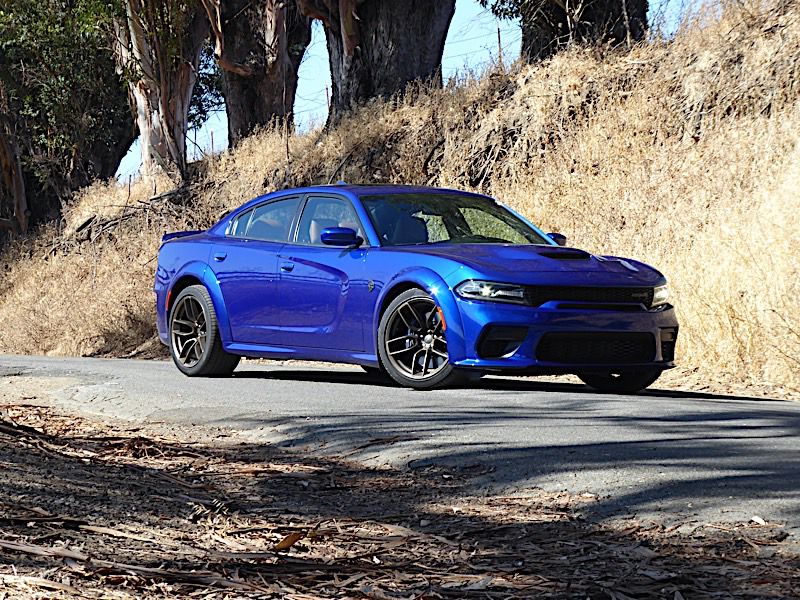
20chargerhellcatwidebodyfrontbeauty3sessions ・ Photo by Ron Sessions
Proof that we’re not quite done yet with furiously fossil-fueled V8 sedans is the sensational, supercharged 2020 Dodge Charger SRT Hellcat Widebody. The Widebody appellation may be a mouthful but it denotes a new evolution of the Charger Hellcat with more grip and enhanced high-speed handling capabilities, complementing its already-extraordinary 707 horsepower and 196-mph top speed.
There’s nothing subtle about the Charger Hellcat Widebody, from its broad shoulders to its predatory gaze, melodic pipes, and the ability to turn the rear tires into smoke at will. The full-size Charger Hellcat Widebody has attitude and a lot of people are going to notice it. As its name implies, the Widebody Hellcat brings fatter tires and wheels, fender flares that make the Hellcat 3.5 inches wider than last year's model. Other changes include a revised grille, fascias, ground effects, and rear spoiler, most of which bring a functional advantage. Priced at $71,140 including the $1,495 destination charge, it’s the priciest Charger you can buy — but a screaming bargain compared to European-brand high-performance sedans approaching similar levels of performance. Dodge recently afforded me a chance to sample the new Charger SRT Hellcat’s upgraded equipment on Sonoma Raceway’s 2.5-mile road course.
You bet it's got a Hemi.
This is one car you park with the hood open at Cars and Coffee events. Dodge has gotten religion on underhood appearance, with tidy hose and wire routings complementing the handsome supercharged 6.2-liter Hemi V8 nestled neatly between the shock towers. This brawny music-maker sounds as good as it looks, courtesy of a big-inch dual-mode active performance exhaust system that dials in just the right amount of lusty rumbles, crackles, and pops to reinforce the Hellcat’s performance persona. While some electric cars can quietly whirr to 60 mph in 4 seconds, the Charger Hellcat makes a memorable public statement of its 3.6-second rampage.
Remember the “King of the Hill” series where the guys gathered around a car with its hood open? Well, this engine, with its 707 horsepower and 650 lb-ft of torque, would be the perfect prop. Need more power? The Widebody Daytona 50th Anniversary Edition ($75,635) packs 717 hp. Or, if you don’t need the four doors, switch over to a Dodge Challenger SRT Hellcat Redeye with its 797-hp 6.2-liter Hemi. EPA estimates for the 2020 Charger Hellcat aren't yet available, but the 2019 model scored 13 mpg city/22 mpg highway/16 mpg combined on 91-octane premium fuel.
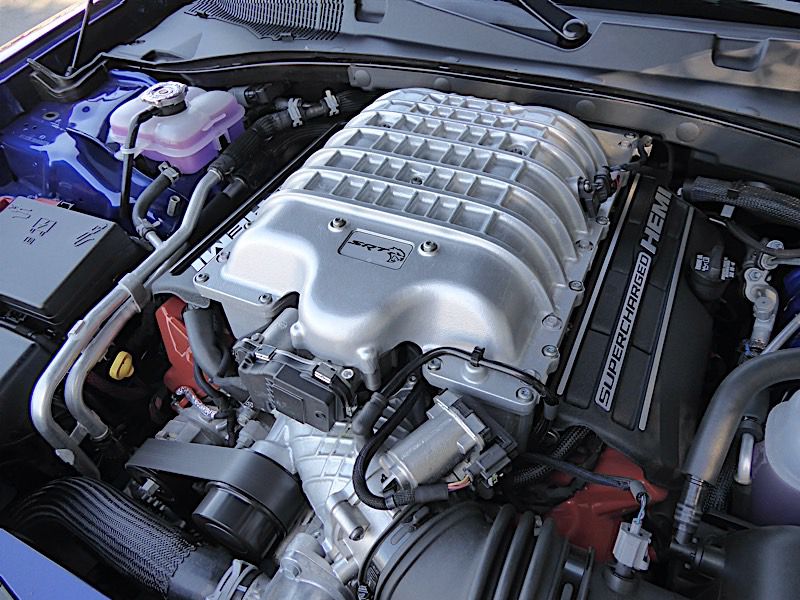
Photo by Ron Sessions
Cabin for Cool Cats
If you didn’t look in the back seat, this cockpit snapshot could have been taken in a muscle coupe. The view hasn’t changed significantly since the current-generation Charger’s introduction in 2011. But this four-door sedan has aged well. Nothing is overdone or in poor taste. More than cop car fare, the French-stitched leather (on the dash, door uppers, console, and armrests) and optional carbon fiber trim wouldn’t look out of place in a premium-brand European car.
Standard Hellcat accouterments include dual-zone automatic climate control, a 200-mph speedometer, the SRT Performance Pages infotainment view, dark engine-turned aluminum trim, LED ambient lighting, and leather trim on the shift knob and steering wheel. The wheel flat-bottom steering wheel is also heated and provides tilting and telescoping adjustments, and the automatic transmission has paddle shifters for manual gear selections. A suede headliner is optional.
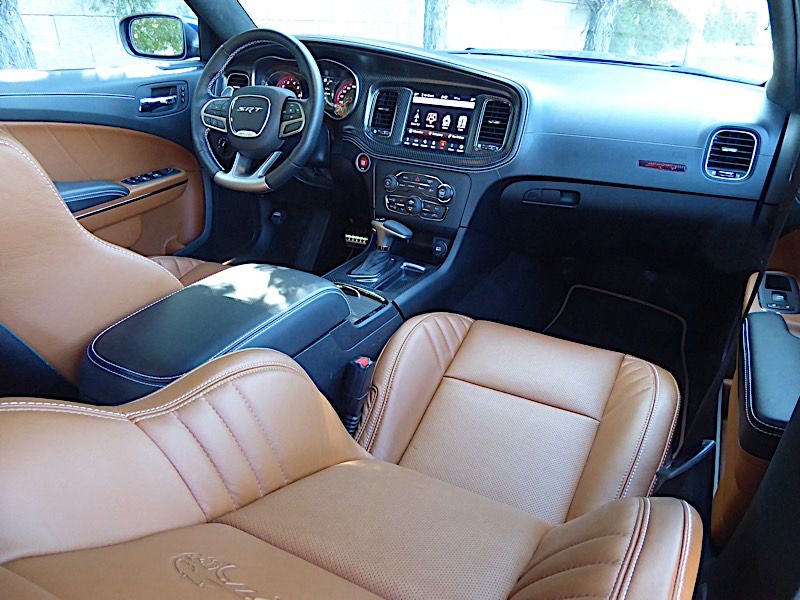
Photo by Ron Sessions
Hellcat Connectivity
Dodge’s highly regarded Uconnect 4C system with an 8.4-inch display may not be the biggest show on the digital screen, but its touchscreen affords easy to navigate the audio system, climate controls, and vehicle information with big, brightly colored tiles, integrated voice command, and simple analog volume and tuning controls. Apple CarPlay and Android Auto connectivity are built in, as is SiriusXM satellite radio. Navigation with 3D mapping is optional. There is a pair of USB ports in the console.
The Uconnect screen is also the gateway to the Charger Widebody’s SRT Street, Custom, Sport, or Track drive modes. These enable the driver to customize engine output, transmission shift mapping, steering effort, adaptive suspension damping, and traction control settings. Word to the wise: Track mode unleashes the Hellcat beast. And if you ever tire of the music broadcasted by the Hellcat V8, know that the standard six-speaker AM/FM stereo can be upgraded to an optional, thumpin’ 19-speaker Harman Kardon premium audio system.
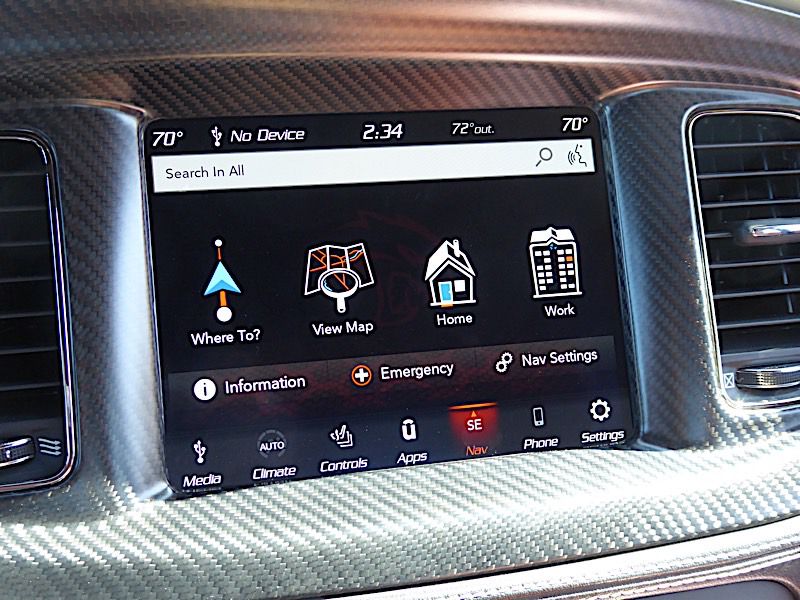
Photo by Ron Sessions
VIP Seating
Handsome in Sepia tones and wrapped in extra-buttery Laguna leather, these well-bolstered sport buckets offer generous thigh and thorax support without hard wings or punishing hot spots.
In the Charger Hellcat, the seats are heated and cooled, with driver’s seat memory and full power adjustment including lumbar settings. Unlike some cars at this price point, no massage functions are available — that task left to the 707-hp Hemi under the hood.
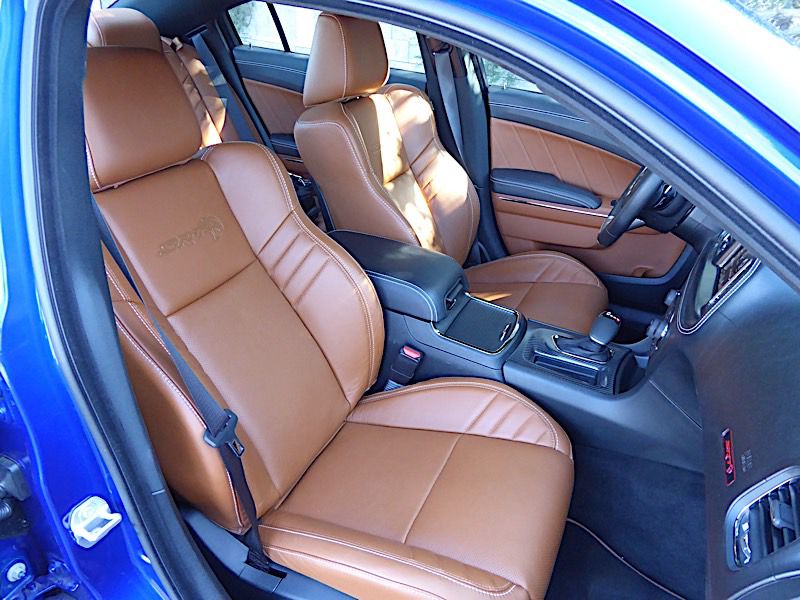
Photo by Ron Sessions
Aft Accommodations
Six-footers sharing this back seat will rub elbows. And headroom is clipped slightly due to this sedan’s sloping, coupe-like roofline. But surprisingly, there’s almost as much rear legroom as there is for front-seat occupants — which is exceedingly rare these days.
Standard Hellcat amenities include heat for the outboard rear passengers, an extra pair of USB ports, rear climate-control vents, a fold-down center armrest, and the same French-stitched soft leather covering the seats, upper door trim, and door armrests that cheers the front passenger area. Also, the rear seatbacks are split 60/40 and fold down, adding extra storage space for long items to the big 16.5-cubic-foot trunk.
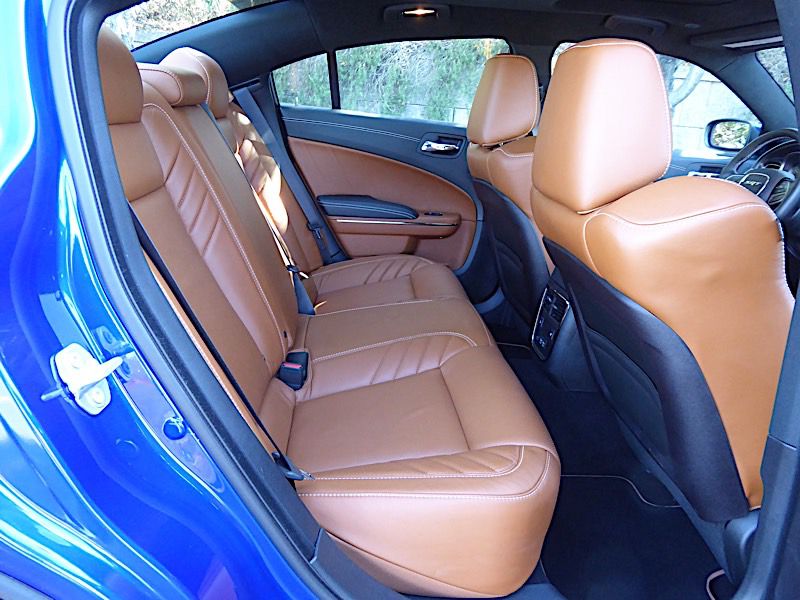
Photo by Ron Sessions
The Burnout
Like ham and eggs, Hellcats and burnouts are an item. Yeah, it’s juvenile, wastes fuel, dings your tire budget, and may damage some asphalt, but it’s super hard to resist spinning the rear tires once in a while with this car. In normal driving, the Widebody’s extra-wide 305/35ZR20s and traction control do a great job of preventing wheelspin. The Hellcat is also equipped with Launch Assist, which modifies engine torque to quell wheel hop.
That said, the Hellcat has some performance technologies that will provide significant entertainment. One is Line Lock, which brakes the front wheels while allowing the rears to spin to “clean” the tires. The other is Launch Control, which for those who haven’t used such a system before, it provides the quickest way to get the car to 60 mph from rest. After making sure the front wheels are pointed straight down the road and the eight-speed automatic transmission is in Drive, simply engage Launch Control via the button on the center stack below the Uconnect screen, mash the brake pedal with your left foot, do the same for the accelerator with your right foot for just a few seconds — and then lift off the brake and hang on.
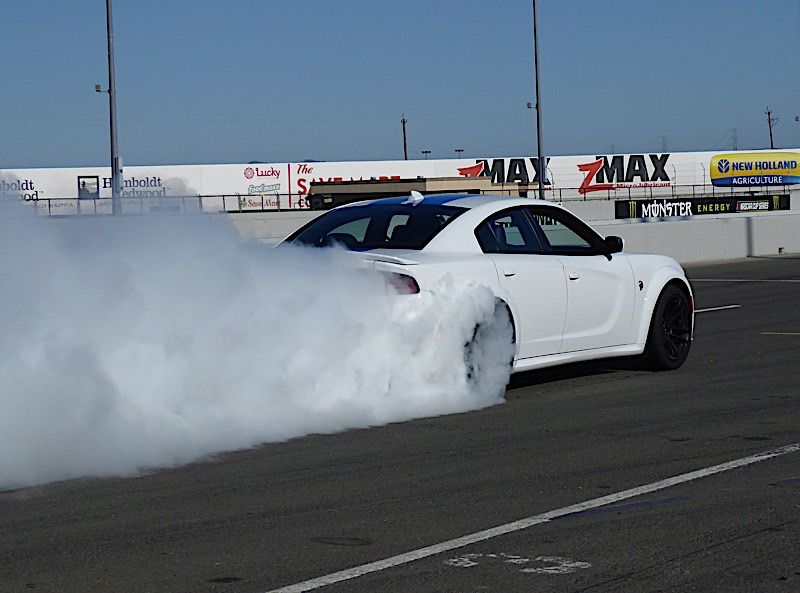
Photo by Ron Sessions
Stab and Stick
The wide-body physique is more than just intimidating. Integrated wheel flares add 3.5 inches of width, which allows Dodge to shoehorn some of the widest rubber available on any sedan for any price. These Michelin PZero 305/35R20 tires (standard all-season or optional performance three-season compound) wrap massive, big-offset 20x11-inch forged aluminum wheels at all four corners.
Big power requires big, heat-resistant binders and plenty of stick. The Brembo brakes — large-pizza-sized 15.4-inch two-piece slotted and vented rotors and six-piston calipers up front and 13.8-inch rotors and four-piston calipers at the rear — held up well despite multiple hot laps around the twisty, hilly 2.5-mile road course at Sonoma Raceway. There was absolutely no fade or rotor roughness. Handling is also pretty impressive for a sedan this big and heavy. Weight distribution isn’t bad with just 54% of the Hellcat’s mass over the front wheels. And while the steering is on the heavy side, but at 2.5 turns lock to lock, the new electric power steering is fairly quick. With the big rubber, turn-in is sharper and it’s easier to get on the power sooner exiting a curve. Dodge says lateral grip is now 0.96g, up from 0.90g with last year’s smaller 275/40ZR tires.
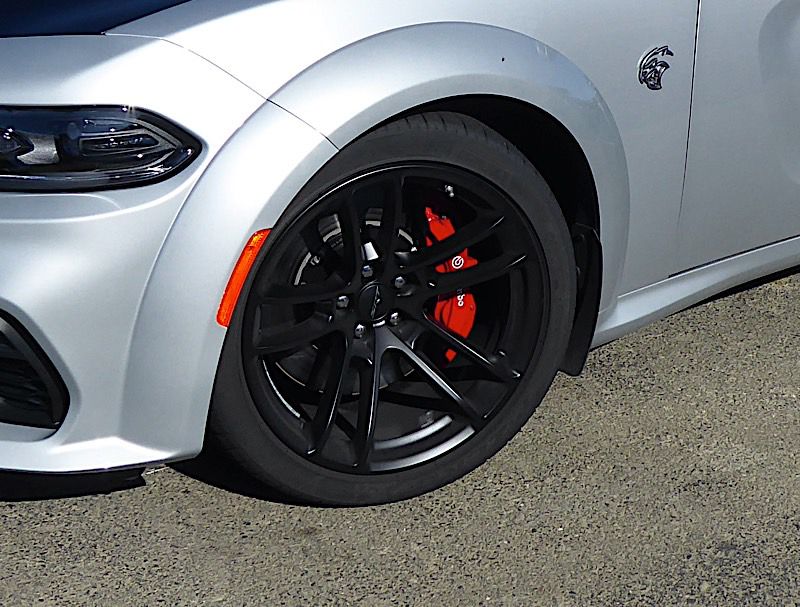
Photo by Ron Sessions
Safety Considerations
Some safety features and advanced driver-assistive tech available in lesser Charger models are missing from the Charger Hellcat. We learned that Dodge had to delete the Charger's front radar sensor to make way for the Hellcat's beefed-up engine cooling system. One missing feature is adaptive cruise control — but then again, Hellcat drivers probably want to be out in front of traffic, not dutifully following it. Also absent from the Charger Hellcat are a forward-collision warning with automatic emergency braking, plus a lane-departure warning and lane-keep assist system. Making up a bit for these omissions in the Hellcat are standard blind-spot and rear cross-traffic warning systems, which cost extra in other Charger trims.
All Charger models, including the Hellcat, come with a standard backup camera and sonar rear park assist that beeps faster the closer the rear bumper gets to making hard contact with an obstacle. Memorize this safety stuff to tell your significant other about when you express your desire to make this Charger your own.
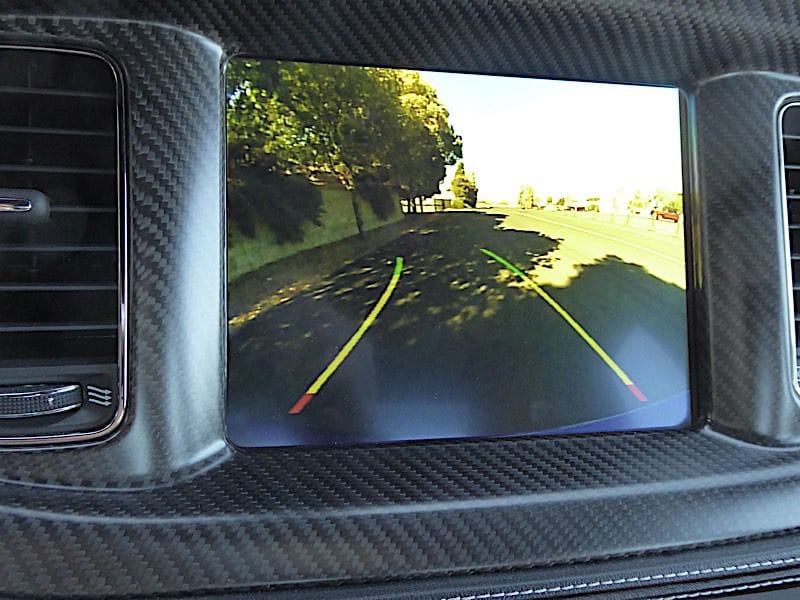
Photo by Ron Sessions
Where to Get One
While some of your friends may have to defend their desire to stash a hot Camaro or Mustang in the garage that only seats two comfortably, the five-seat, four-door Charger Hellcat has room for the whole family.
Yet while this big sedan is suitable as a roomy family car for Sunday drives in the country, its 707 hp, 3.6-second 0-60 capability, and 0.96g of lateral grip are stats to keep in mind the other days of the week. The 2020 Dodge SRT Charger SRT Hellcat Widebody will be in Dodge showrooms after the first of the year.
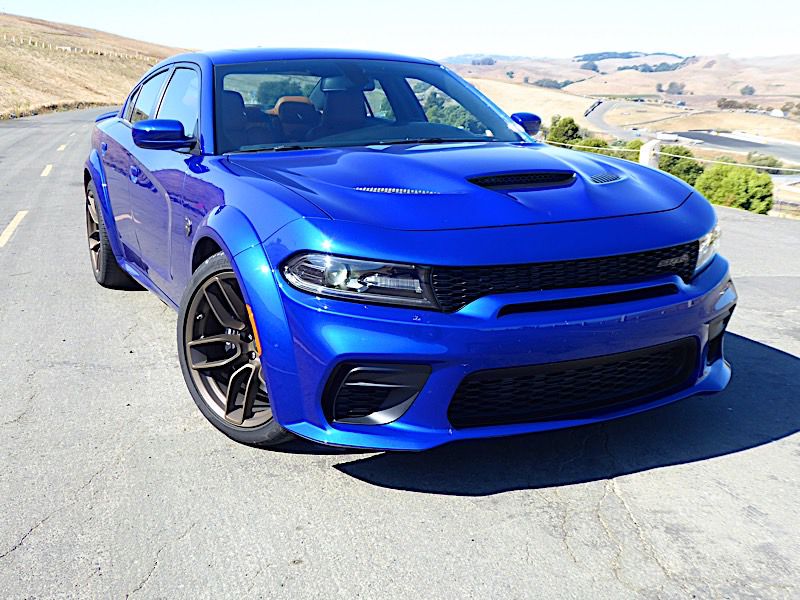
Photo by Ron Sessions